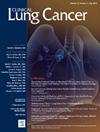Induction Immunochemotherapy Followed by Hypo-Fractionated Radiotherapy in Unresectable Stage III Non–Small Cell Lung Cancer
IF 3.3
3区 医学
Q2 ONCOLOGY
引用次数: 0
Abstract
Purpose
To evaluate the efficacy and safety of induction immunochemotherapy followed by hypo-fractionated radiotherapy (Hypo-RT) for locally advanced unresectable non–small cell lung cancer (LA-NSCLC).
Methods
This retrospective analysis involved the data of 35 patients with unresectable stage III LA-NSCLC receiving immunotherapy plus Hypo-RT from January 1, 2019, to December 31, 2023. At least 2 cycles of induction immunochemotherapy were initially administered, followed by a definitive Hypo-RT at 4 Gy per fraction. The primary endpoint was overall survival (OS) and the secondary endpoints were progression-free survival (PFS) and grade ≥ 3 nonhematologic toxicities. Time-to-event outcomes for the entire cohort were calculated using the Kaplan–Meier method.
Results
At a median follow-up of 31.5 months (95% confidence interval, 26.1 to 36.9 months), median OS did not reach, with 1, 2, and 3-year OS rates of 100.0%, 82.5%, and 77.3%, respectively. Disease progression or death was recorded in 18 (51.4%) patients, with a median PFS of 28.0 months (95% CI, 9.4 to 46.6 months). The 1, 2, and 3-year PFS rates were 74.3%, 55.7%, and 47.6%, respectively.
Conclusion
Induction immunochemotherapy followed by Hypo-RT demonstrated promising efficacy and acceptable toxicity in patients with LA-NSCLC. Studies on Hypo-RT combined with induction and consolidation immunotherapies are warranted in the future.
不可切除的III期非小细胞肺癌的诱导免疫化疗后低分级放疗。
目的:评价诱导免疫化疗后低分级放疗(Hypo-RT)治疗局部晚期不可切除非小细胞肺癌(LA-NSCLC)的疗效和安全性。方法:回顾性分析了2019年1月1日至2023年12月31日期间35例接受免疫治疗加hypor - rt的不可切除III期LA-NSCLC患者的数据。最初进行至少2个周期的诱导免疫化疗,随后进行确定的低放射治疗,每次4 Gy。主要终点是总生存期(OS),次要终点是无进展生存期(PFS)和≥3级非血液学毒性。使用Kaplan-Meier方法计算整个队列的事件发生时间结果。结果:中位随访31.5个月(95%可信区间26.1 ~ 36.9个月),中位OS未达到,1年、2年和3年OS率分别为100.0%、82.5%和77.3%。18例(51.4%)患者出现疾病进展或死亡,中位PFS为28.0个月(95% CI, 9.4至46.6个月)。1年、2年和3年PFS分别为74.3%、55.7%和47.6%。结论:诱导免疫化疗后低剂量放疗对LA-NSCLC患者具有良好的疗效和可接受的毒性。hyport联合诱导和巩固免疫疗法的研究在未来是有必要的。
本文章由计算机程序翻译,如有差异,请以英文原文为准。
求助全文
约1分钟内获得全文
求助全文
来源期刊

Clinical lung cancer
医学-肿瘤学
CiteScore
7.00
自引率
2.80%
发文量
159
审稿时长
24 days
期刊介绍:
Clinical Lung Cancer is a peer-reviewed bimonthly journal that publishes original articles describing various aspects of clinical and translational research of lung cancer. Clinical Lung Cancer is devoted to articles on detection, diagnosis, prevention, and treatment of lung cancer. The main emphasis is on recent scientific developments in all areas related to lung cancer. Specific areas of interest include clinical research and mechanistic approaches; drug sensitivity and resistance; gene and antisense therapy; pathology, markers, and prognostic indicators; chemoprevention strategies; multimodality therapy; and integration of various approaches.
 求助内容:
求助内容: 应助结果提醒方式:
应助结果提醒方式:


